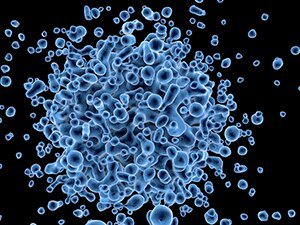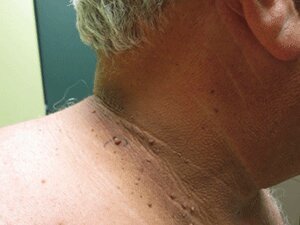Papillary lesions cause a lot of discomfort not only due to external changes in the skin. Many papillomas are located with increased risk of injury, including friction and infection. All these factors can provoke the spread of rash and malignancy in the cells of the neoplasm. Before starting treatment, mandatory diagnostics are performed to identify the causes and the nature of the structure of the structure. What causes papillomas on the body, what does the body signal about? Let's find out in this article.
Papillomas on the body - what do they mean, what does the body say?

Papillomas on the body only mean an indisputable fact - a person has become a carrier of papillomavirus infection with a progressive course. The main route of transmission of the virus to the body is sexual, but infection is possible through kisses, handshakes or by contact in the household.
The known types of papillomas on the body differ from each other in terms of structural features, color, size and density. Of course, not all carriers of a viral infection suffer from multiple or single rashes on the body. Activation of pathogenic viral activity usually occurs due to a persistent decrease in immunity.
Some patients even compare papillomas with moles, but papillomas have a number of fundamental differences:
- presence of a vascular component;
- preferential placement in places of friction, sweat;
- loose and soft structure.
Papilloma resembles a papillary growth on a pedicle. The greatest danger of papillomas lies in the cancerous formation of skin cells.
The risk group includes patients with worsening clinical history and life history as well as those who have had cancer cases among close relatives.
Papillomas rarely cause concern to a person without causing pain and local symptomatic manifestations. Clinicians even call such neoplasms a "time bomb" that can spontaneously malignant under the influence of various negative factors.
The virus may not appear for years, but a person is a carrier of the infection even with strong immunity. More often it is men who become the culprits of a woman's infection during unprotected intercourse.
The main reasons for the appearance

The main cause of rashes on the body is the body's defeat with human papillomavirus infection.
The predisposing factors for viral activity are:
- chronic diseases of internal organs and systems
- skin trauma of any genesis;
- skin infection
- allergic diseases;
- autoimmune conditions of congenital nature;
- genital infections and inflammatory diseases of the genitals.
Any pathological processes and dysfunctions of internal organs can suppress the activity of the immune system, impair overall health and weaken the body. With a sustained decrease in immune forces, the virus begins pathogenic activity and gradually replaces DNA from healthy cells with viral ones. Thus, the regenerative process is disrupted at the cellular level, chaotic treatment of cells and the formation of neoplasms begins.
The virus actively affects the deep layers of the epidermis, therefore, the first symptom of a developing infection is the emergence of papillomatous foci.
Appearance in men
Frequent localization of papillomas in men - genitals and penis, face, armpits.
Hypothermia and increased susceptibility to adverse external factors are considered as frequent factors for lowering immunity in men:
- bad habits (tobacco, alcohol)
- peculiarities of labor (heavy production work, hot workshops, radioactivity):
- increased stress factor;
- active sex life (especially at a young age).
HPV in men is often combined with other sexually transmitted infections. Infection often occurs in men who neglect the use of barrier to contraception. Although the HPV virus can enter the body even when using a condom.
The most important HPV prevention is vaccination. It is recommended to inject the vaccine three times during puberty, long before active sexual activity begins. Doctors recommend starting vaccination of children aged 10-12 years.
Causes of multiple papillomas

Multiple papillomas on the body with limited or widespread localization indicate depletion of the body. Usually, several rashes are associated with general malaise, drowsiness and unexplained weakness in the patient.
Viral activity in the epidermal layers is usually on a large scale, therefore the appearance of new papillary foci occurs rapidly.
Often, the virus itself can provoke the development of various diseases that only complicate the course of the infectious process.
The following diseases and conditions can be a trigger for the general spread of papillary foci throughout the body:
- acute infectious processes of any kind and location
- sunburn, overuse of solarium or tanning in open sun
- metabolic disorders
- inadequate nutrition, lack of nutritional regime, unbalanced diet;
- oncological tumors of internal organs, skin;
- HIV or AIDS;
- persistent psycho-emotional instability, stress, mental disorders;
- age-related changes.
The rapid spread of papillomas through the body is induced by the patient's obesity. With increased weight, sweat glands are activated so that papillomas in the armpits and in the skin folds are more visible. Clinicians notice a noticeable spread of infectious growths with increased weight during the hot summer months.
Neoplasms can occur not only due to serious diseases and autoimmune conditions. Bad habits, intense physical activity, severe stress can also provoke the activity of a viral infection.
When skin neoplasms occur in patients, a natural question arises as to the tactics for treating and removing the growth.
Therapy Features

A viral infection can be present in the body for a long time without visible manifestations. In patients, on the basis of good health, the virus may never appear in their lives. The first symptoms are found with weakened immunity.
Doctors do not recommend starting self-treatment without diagnosis and medical advice for several reasons:
- it is visually impossible to determine the structure and nature of the neoplasm;
- the patient is unable to assess the level of oncogenic hazard;
- inadequate treatment with some means can aggravate the situation, for example burns, secondary infection.
Differential diagnosis significantly improves therapeutic results for skin lesions, as it identifies the nature of the rash and allows you to choose the only appropriate treatment.
Modern dermatology and cosmetology offer two main ways to remove papillomas on the body:
- Drug therapy- the use of local and systemic drugs;
- Surgical Removal- the use of the latest hardware techniques and traditional surgery.
In the first case, a course of antiviral and immunomodulatory therapy should be prescribed. These drugs for papillomas on the body are needed to stop viral activity and improve the patient's immune status.
Local treatment does not always give the expected results, therefore clinicians together with conservative medicine offer a number of surgical techniques:
- scalpel excision;
- removal by radio wave method
- laser removal of papillomas;
- electrocoagulation;
- exposure to a chemical solution
- freezing of liquid nitrogen.
No surgery can rule out recurrent tumors, so you should definitely take a course of active antiviral therapy.
Along with treatment, it is important to maintain a healthy lifestyle, diet, sleep and alertness. Most patients are rarely aware of these recommendations and their implementation is very important for the successful treatment of HPV.
The human papillomavirus itself poses no danger, but the risk of malignant neoplasm cells always remains.
To minimize HPV infection, strict adherence to intimate and personal hygiene, sexual order is recommended. Early diagnosis significantly reduces the risk of developing complications.














































































